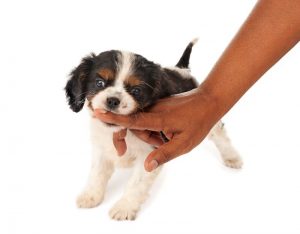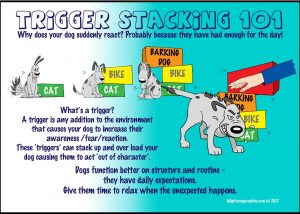 < Updated 05JUL21 >
< Updated 05JUL21 >
< http://bit.ly/EspcNewPuppyParents >
If you have a new puppy that is 8 to 16 weeks of age, this is the article you want. If you have a dog older than 12 weeks of age, you may also wish to check out this article – http://bit.ly/EspNewDogParents
A puppy does not come with a user’s manual; at least none that are complete and accurate. This article and series of links to other articles and podcasts are meant to get you started on learning what you need to know about caring for your puppy. However, it does not take the place of enrolling yourself, and your puppy in a puppy headstart or kindergarten class that is under the direction of a professional dog trainer, accredited by an independent certification body and that is committed to pain-free, force-free, and pain-free training. If you prefer to absorb information by listening, rather than reading, you may want to listen to these three podcasts.
Podcast – Especially for New Puppy Parents – Part 1 – http://bit.ly/WfMw-Esp_Pups1
Podcast – Especially for New Puppy Parents – Part 2 – http://bit.ly/WfMw-Esp_Pups2
Podcast – Especially for New Puppy Parents – Part 3 – http://bit.ly/WfMw-Esp_Pups3
A new puppy can be a great addition to your family, but they will also require some work on your part. You will very likely have questions about; housetraining, socialization, play biting and nipping, chewing, training methods, wellness exams, nutrition, vaccinations, babies and dogs, kids and dogs and more. This post includes links to articles and podcasts that address the most common questions people ask me when they are thinking of getting a new puppy or that have just added one to their home. While we strongly encourage everyone to attend a Puppy Headstart class while the puppy is between 8 and 16 weeks of age, these materials will provide you with some additional information. You can read or listen to them in any order you choose; however, I believe you will get the most benefit if you go through them in the order that they are listed.
My first word of advice; “patience.” It is very easy to want the ideal puppy immediately, but just as “Rome was not built in a day,” Your puppy will not be the perfect companion in a week, nor in all likelihood in a month. Training is a process, and as such it takes time. Yes, there will times you may become frustrated, but when you look back in a year you will realize it was a precious time for you and your pup, one filled with learning and fun!
I encourage you to read the following shared blog post, all about patience, by dog trainer Nancy Tanner. Read it, print it, and then post it on your refrigerator, or somewhere in your home where it is close at hand anytime you are feeling frustrated with your puppy. –
Shared Blog Post – the misunderstanding of time by Nancy Tanner – http://blog.greenacreskennel.com/2016/11/16/shared-blog-post-the-misunderstanding-of-time-by-nancy-tanner/ OR http://bit.ly/Patience-Dogs
Enrolling yourself and your puppy in a reward-based dog training class designed by a Certified Professional Dog Trainer is the best thing you can do for you and your dog. Not all trainers and dog training classes are equal. Because dog training is currently a non-regulated and non-licensed profession the quality of instruction and practices used can vary widely, sometimes into the inhumane. The following article will provide you with information on what to look for in a dog trainer and dog training facility.
FMI – How to Choose a Dog Trainer – http://blog.greenacreskennel.com/2017/01/08/how-to-choose-a-dog-trainer/ OR
http://bit.ly/HowToChooseADogTrainer
What You Need to Know BEFORE You Start Training – https://bit.ly/BeforeYouTrainYourDog
Do not try to teach your puppy everything at once. In class, we will teach you certain behaviors, in a specific order, for a reason; to make training easier.
During the critical socialization period, between 8 and 16 weeks of age, it is far more important to work on planning and appropriately socializing and habituating your dog than it is to teach them to shake or any other behavior. This is a limited period, and you want to make the most of it. Inadequate or inappropriate socialization is a common reason dogs develop behavioral problems such as aggression and anxiety.
FMI – Puppy Socialization and Habituation – http://blog.greenacreskennel.com/2015/06/27/dog-behavior-puppy-socialization-and-habituation/
OR http://bit.ly/SocializationPuppy
If you are already having problems with your dog guarding food and other items, stealing things, or growling, make an appointment with us for a Help Now! session as soon as possible. Punishment in any form will likely make these behaviors worse and could result in someone being bitten.
FMI – What Should I Dog When My Dog Does Not Let Me Take Something They Have Stolen and Snaps or Tries to Bite Me? – http://blog.greenacreskennel.com/2017/08/20/what-should-i-do-when-my-dog-does-not-let-me-take-something-they-have-stolen-and-snaps-or-tries-to-bite-me/
OR http://bit.ly/StealGuardGrowlSnap
FMI – What Should I Do When My Dog Growls? – http://blog.greenacreskennel.com/2015/07/18/canine-behavior-what-should-i-do-when-my-dog-growls/
OR http://bit.ly/DogGrowls
Dogs and children both need training and supervision to learn how to appropriately and safely interact with one another. Dogs and children will not automatically get along. If you do not have children, your dog will still need to be socialized with children and learn how to interact with them. If you have children and a dog, you will need to spend time working with both. I highly recommend the book A Kids’ Comprehensive Guide to Speaking Dog! by Niki Tudge. You will discover some things that you probably did not know about dogs while learning how to teach your children about interacting with your dog and any other dog they may meet.
FMI – Book Review – A Kids’ Comprehensive Guide to Speaking Dog! by Niki Tudge – http://blog.greenacreskennel.com/2018/01/10/book-review-a-kids-comprehensive-guide-to-speaking-dog-by-niki-tudge/
OR http://bit.ly/BkRvw-KidsGuide-Tudge
Think carefully about what you teach your puppy; intentionally or unintentionally. Un-training a behavior takes a whole lot more time and energy than training a behavior. A trick like “shake” is cute, but think long and hard if you want a dog that will always be trying to get every person they see to shake, even when they have muddy paws.
If there are multiple people that will be interacting with your dog, discuss what cues, visual and verbal, that you will use for specific behaviors so that you are all being consistent. Do not be in a hurry to add a visual (hand signal) or a verbal cue to a behavior. We do not start using a cue until we are confident that the dog understands the behavior in multiple contexts and environments. If you start using the cue to soon, you may need to change it. We will talk about that more in class.
If you have questions that just will not wait until class starts, contact us and make an appointment for a Help Now! session.
Blog Posts
 The blog posts listed below will all be very useful for anyone thinking about getting a new puppy or for those of you that just added a puppy to your family.
The blog posts listed below will all be very useful for anyone thinking about getting a new puppy or for those of you that just added a puppy to your family.
How to Choose a Dog Trainer – http://blog.greenacreskennel.com/2017/01/08/how-to-choose-a-dog-trainer/ OR http://bit.ly/HowToChooseADogTrainer
Themes in Puppy Training
Themes in Puppy Training – What You Need to Know BEFORE You Start Training – https://bit.ly/BeforeYouTrainYourDog
Puppy Socialization and Habituation – http://blog.greenacreskennel.com/2015/06/27/dog-behavior-puppy-socialization-and-habituation/
OR http://bit.ly/SocializationPuppy
Things I Wish I Had Known Before I Started Training Dogs – Gus, the Dominance Myth, An Alpha Roll, and a Damaged Relationship – http://bit.ly/Things-Gus-Dominance
Things I Wish I Had Known Before I Selected My First Dog – Aversives are Unnecessary and Counter-Productive When Training A Dog – Part 1 – WWM-JAN2019 – http://bit.ly/Things-Aversives-1
Things I Wish I Had Known Before I Selected My First Dog – Aversives are Unnecessary and Counter-Productive When Training A Dog – Part 2 – WWM-FEB2019 – http://bit.ly/Things-Aversives-2
Dog Behavior – Dominance: Reality or Myth – http://blog.greenacreskennel.com/2015/06/20/dog-behavior-dominance-reality-or-myth/ OR http://bit.ly/Dominance-RealityorMyth
The Unintended Consequences of Shock Collars – http://blog.greenacreskennel.com/2013/08/05/dogs-the-unintended-consequences-of-shock-collar/
Canine Communication & Stress
Introduction to Canine Communication – http://blog.greenacreskennel.com/2016/01/16/dog-behavior-introduction-to-canine-communication/
Understanding, Identifying and Coping with Canine Stress – http://bit.ly/Canine-Stress
Essential Handouts On Body Language, and Canine and Human Behavior from Dr. Sophia Yin – https://bit.ly/YinBodyLang
Jaws & Paws
Play Biting – Biting and Bite Thresholds – http://blog.greenacreskennel.com/2012/01/16/dog-training-biting-and-bite-thresholds/
Play Biting – Help! My Puppy’s A Land Shark! – http://blog.greenacreskennel.com/2015/03/01/canine-behavior-help-my-puppys-a-land-shark/
Puddles & Piles
Housetraining – http://blog.greenacreskennel.com/2014/02/16/housetraining/
OR http://bit.ly/HousetrainingYourDog
Alone Training – Preventing separation anxiety – Teaching your dog to cope with being alone – http://blog.greenacreskennel.com/2016/03/14/dog-training-preventing-separation-anxiety-teaching-your-dog-to-cope-with-being-alone/
Grabs & Nabs
Chewing – http://blog.greenacreskennel.com/2013/03/15/dog-training-chewing/
The Power of Food3
Teaching the ATTENTION or LOOK Behavior – http://blog.greenacreskennel.com/2016/04/04/dog-training-teaching-the-attention-or-look-behavior/
Health & Safety
Tobacco Smoke, Vaping, Nicotine, and The Risk They Pose to Our Pets – https://bit.ly/Pets-Nicotine-APR21
Summer Pet Care Tips – http://bit.ly/Summer-Pet-Tips
Cold Weather and Holiday Tips for Pets – https://bit.ly/WfMw-Cold2021
Canine Nutrition
GAKS Philosophy on Pet Nutrition – http://bit.ly/GAKS_Nut_Phil
Pet Foods We Offer At Green Acres Kennel Shop – http://bit.ly/GAKS_PetFood_Brands
Pet Nutrition – Which Companies Are Behind Your Pet’s Food? – http://bit.ly/PetFoodComp
What I Feed My Dog and Why I Feed What I Do – https://bit.ly/WhatIFeedAndWhy
Podcast – What We Feed Our Pets and Why, with – Don Hanson, Kate Dutra, and Linda Case – https://bit.ly/WfMw-WhatWeFeed-11JUL20
Which Are the Best Treats for Dogs? – https://bit.ly/WhichTreats
Pet Nutrition Facts – Do You Want Optimal Nutrition, Low Cost, or Convenience? You CANNOT Have It All, a four-part series – http://bit.ly/PetNut-Opt-Cost-Con
Podcasts-Two Conversations with Animal Nutritionist Dr. Richard Patton – https://bit.ly/WfMw2wPattonAPR21
Pet Nutrition: Some Myths and Facts – Part 1 – My story with Gus – Maine Dog Magazine – Winter 2017 – http://bit.ly/Gus-Nutrition
Pet Nutrition – The Science and Dogma of Pet Nutrition with Dr. Richard Patton with link to 1-hour video – http://bit.ly/Video-Dr-Richard-Patton
Podcast – Pet Fooled – A Look Inside A Questionable Industry with Kohl Harrington – http://bit.ly/WfMw-Pet-Fooled
Pet Fooled – A Look Inside A Questionable Industry – The Video – https://www.petfooled.com/pet-fooled-part-1.html
Pet Nutrition – The Wisdom of Rotating Your Pets Diet – Part 1 – http://bit.ly/DietRotation1-30JUL19
Pet Nutrition – The Wisdom of Rotating Your Pets Diet – Part 2 – http://bit.ly/DietRotation2
Podcast – DCM, the FDA, and Dog Food-the Science and the Hype with Canine Nutritionist Linda Case – http://bit.ly/Blog-DCM-FDA-8AUG19
Shared News Story – An Exposé on Prescription Diets from WJLA ABC7 News – http://bit.ly/Nut-RXDiets-WJLA-24MAY19
The Scientific Benefits of Feeding Raw, All in One Place-Dr. Karen Becker interviews Dr. Conor Brady, author of Feeding Dogs: The Science Behind The Dry Versus Raw Debate – https://healthypets.mercola.com/sites/healthypets/archive/2021/05/23/dry-versus-raw-dog-food.aspx
Pet Food Myths & Facts – No. 1 – MYTH – Only a Board-Certified Veterinary Nutritionist is qualified to formulate pet food – http://bit.ly/PetFoodMyths-Facts-4MAR21
WSAVA Body Condition Score for Canines – https://wsava.org/wp-content/uploads/2020/01/Body-Condition-Score-Dog.pdf
WSAVA Body Condition Score for Felines – https://wsava.org/wp-content/uploads/2020/08/Body-Condition-Score-cat-updated-August-2020.pdf
An Intro to the Recall Behavior & Walking Politely
Teaching Your Puppy to Come When Called – Starting Points – http://blog.greenacreskennel.com/2017/07/10/dog-training-teaching-your-puppy-to-come-when-called-starting-points/
How Do I Get My Dog to Walk Politely Instead of Pulling on the Leash? – http://blog.greenacreskennel.com/2017/04/27/dog-training-how-do-i-get-my-dog-to-walk-politely-instead-of-pulling-on-the-leash/
Dogs and Children
Recommended Resources on Kids & Dogs – http://bit.ly/GAKS_Kids_DogsResources
Book Review – A Kids’ Comprehensive Guide to Speaking Dog! by Niki Tudge – http://blog.greenacreskennel.com/2018/01/10/book-review-a-kids-comprehensive-guide-to-speaking-dog-by-niki-tudge/
Book Review – Living with Kids and Dogs…Without Losing Your Mind: A Parent’s Guide to Controlling the Chaos by Colleen Pelar – http://blog.greenacreskennel.com/2018/01/10/book-review-living-with-kids-and-dogswithout-losing-your-mind-a-parents-guide-to-controlling-the-chaos-by-colleen-pelar/
©05JUL21, Donald J. Hanson, All Rights Reserved <Click for Copyright and Use Policy>
 This episode of The Woof Meow Show from March 9th, 2019 is the second show in a three-part series. Kate and Don discuss; play biting, roughhousing, the importance and benefits of starting a Puppy Headstart class by the time the puppy is 10-weeks old, handling for grooming and routine care, managing kids and a puppy, growling, stealing, play, and chewing. You can find a list of links to corresponding articles on Don’s blog labeled as:
This episode of The Woof Meow Show from March 9th, 2019 is the second show in a three-part series. Kate and Don discuss; play biting, roughhousing, the importance and benefits of starting a Puppy Headstart class by the time the puppy is 10-weeks old, handling for grooming and routine care, managing kids and a puppy, growling, stealing, play, and chewing. You can find a list of links to corresponding articles on Don’s blog labeled as:




